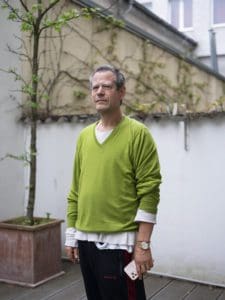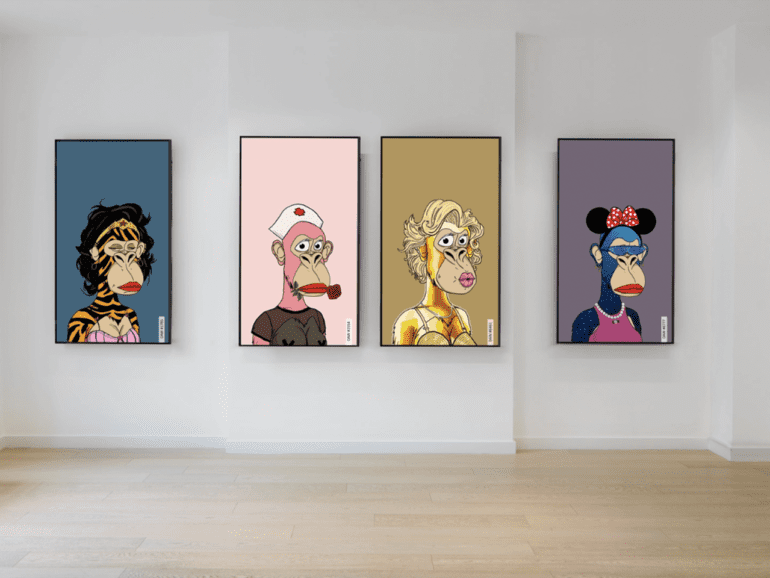There has been an uptake in NFT exhibitions in London, such as ‘Portrait of an Era‘ at HOFA, Eternalising Art History, Unit London, etc.
There was also the launch of the first gallery Quantus, which is dedicated to exhibiting art created on the blockchain all year round and offers advice on making, buying, and selling NFTs.
Kenny Schachter, digital artist and curator of many NFT exhibitions — most notably NFTism: No Fear in Trying at Unit London — explains that NFTs are democratizing who can see art, “the more ways for art to been seen/experienced, the better. A Van Gogh masterpiece has little or no meaning or effect abandoned in a forest (or freeport other than as an asset) – art needs an audience to communicate and complete the equation of an artist’s intent.”
Related:
The financial impact has also been noticeable. Around 28,400 NFTs were sold in the art segment during the previous 30 days as of April 15, 2021. The total sales recorded on the Ethereum blockchain over the past 30 days was 22.6 thousand as of April 15, 2022.
Over the period considered, trading of art NFTs reached a high of 109.1 thousand in the middle of August 2021, according to Statista.

And so, the long-term impact could be “ginormous,” Schachter said.
“We live in digital times; it’s the most important pervasive phenomenon in all of our lives globally. I am neither a coder nor a programmer, but I have employed technology in my art-making solely from an interest in technology.”
“For what is contemporary art but a reflection of our social, political, economic, and tech times. To date, the auction record for a video artwork is a mere $700,000 (by Bill Viola), yet a Leonardo da Vinci painting (more or less by his hand) has sold for $450,000,000, which may soon be eclipsed by an Andy Warhol painting (also more or less by his hand). It’s long overdue that digital art gets an equal footing in the art market.”
Copycat industry
The popularity of NFTs has led to the growth of copycats due to their lucrative nature. Since the inception of NFTs, artists have been complaining that their work has been copied, stolen, and minted on the blockchain. But the problem might worsen as the emergence of the knock-off industry grows. Copycats are testing the boundary between plagiarism and parody.
The issue has even prompted the creation of a Twitter account, @NFTtheft, which has documented some of the most noticeable cases, compiling a valuable thread of resources to help artists if an NFT work of theirs has been subject to forgery.
The Bored Ape Yacht Club (BAYC) case study
BAYC has 10% of the total market cap of NFTs at $1 billion, and with more than $10 billion worth of NFTs currently on the market, its then no surprise that this project has been at the center of the conversation around copycats and the ethical lines of digital art.
BAYC hack
Hacking and theft have become rampant. A smart contract cannot be reversed once made, it can be difficult to reading its contents carefully adetermineing its validity before giving it access to an accoult.
On April 25, Yuga Labs, the multi-billion-dollar collective behind BAYC non-fungible tokens, was the source of another hacking attack, which resulted in the theft of millions of dollars worth of NFTs.
An attacker hijacked BAYC’s Instagram account and sent a fake post for phishing that led many followers to click on it, resulting in their crypto wallets connecting to the hacker’s smart contract. The hacker stole four Bored Ape tokens and a host of other NFTs worth an estimated $3 million.
Similar BAYC projects
- Bored Wukong, a collection of NFT avatars based on the Monkey King, was accused. Known as a monkey king, Wukong is a famous character in Chinese mythology. According to South China Morning Post, they released 390 Bored Wukongs and climbed the ladder on the Chinese NFT marketplace–currently ranking as the second most popular creator on NFTCN by transaction volume.
- Phunky Ape Yacht Club– A play on the word “fake” and the real Bored Ape Yacht Club, two collections were calling themselves the PHAYC launched. PHAYC launched with a website describing the project as “a limited NFT collection where the token itself offers no membership and no allegiance,” a tongue-in-cheek nod to the promise made by BAYC. It stood as a response against centralization, corporations, and celebrities taking over the NFT movement for the creators. PAYC, another project, was also launched in early December with a similar statement around decentralization and criticizing “rich douchebags” who had (allegedly) taken over the original ape market. PAYC and PHAYC have since fought on Twitter over which one is the authentic Bored Ape Yacht Club ripoff, with PAYC’s founder referring to PHAYC as a “cash grab fraud project.” Both PHAYC projects sold out in just a few hours and are now banned from OpenSea due to alleged intellectual property violations. They are relisted on other secondary markets; @phunkyapeyc is currently live on Mintable, while @phaycbot is available on Rarible.)
- Desperate Ape Wives – This collection has 10,000 NFTs of female apes inspired by influential trends. The creator explains, “each DAW was created to have its own distinct appearance and attitude, so the collection is diverse enough for everyone to find a character they can identify with. DAW represents The Freedom To Be Who You Are”. The benefits of joining the community include IP rights, invitations to events, members-only offers from brands, and exclusive airdrops. DAW is currently exhibiting in the Omer Trioche Gallery in London. When asked about the collections’ similarities to BAYC, the gallery explained, “it takes inspiration from the Bored Ape Collection. The artists noticed a lack of female representation and so wanted to take that on.”
Ethical guidelines in digital art
In some ways, however, new ethical guidelines of what is permitted in digital art are still being established. On this topic, Schachter quotes David Levine “Pablo Picasso is widely quoted as having said that ‘good artists borrow, great artists steal; whether or not Picasso was truly the first person to voice this idea is in some dispute. One can find passages in T. S. Eliot’s critical works which discuss how artistic theft of others’ work contributes to the creation of new art. The idea itself is probably much older. Shakespeare routinely stole plotlines and even whole scenes from other writers for his plays. The thematic and technical similarities that characterize art movements are largely due to the deliberate imitation of seminal works of art. But, whoever first put forward the idea, it is an essential truism in the creation of new knowledge.”
“And screw the Apes; they are in the public domain, and copying is flattery.”
Regardless it is clear there are many stakeholders in the emergence of the copycat industry, but what drives the interest of galleries, as Schachter puts it, is finances. “Have you heard my song (and seen the music video) ‘Money, money, money?”


